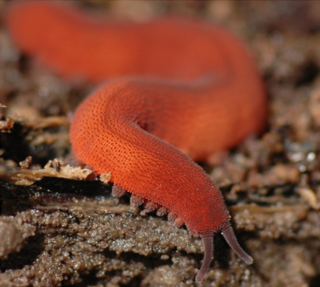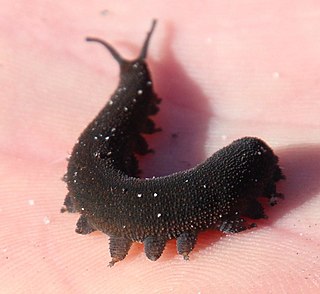
Euperipatoides is a genus of ovoviviparous velvet worms in the family Peripatopsidae. All species in this genus have 15 pairs of legs in both sexes. All species are found in New South Wales, Australia. E. rowelli is also found in the Australian Capital Territory.
Paropisthopatus is a monospecific genus of velvet worm containing the single species Paropisthopatus umbrinus. Females of this species range from 20 mm to 70 mm in length. The type locality is in central Chile. Velvet worms in this genus have 16 pairs of legs. This genus exhibits matrotrophic viviparity, that is, mothers in this genus retain eggs in their uteri and supply nourishment to their embryos, but without any placenta.
Epiperipatus imthurni is a species of velvet worm in the family Peripatidae. This species ranges from light orange or yellowish brown to a dark brown on its dorsal surface; the ventral surface is a lighter orangeish shade of the same color. The type locality is in Guyana. No males have been recorded from this species. Females can reach a large size, up to 2.25 g in weight, and range from 25 mm up to 96 mm in length. They have 29 to 32 pairs of legs, usually 30 or 31. Females from Trinidad were shown to reproduce via parthenogenesis; the only velvet worm known to do so.
Epiperipatus acacioi is a species of velvet worm in the Peripatidae family. This species is dark purple with a bilaterally symmetric pattern on its dorsal surface and ranges from 13 mm to 47 mm in length. Males of this species have 24 to 27 pairs of legs, usually 25 or 26; females have 26 to 30, usually 27 or 28. The type locality is in Minas Gerais, Brazil.

Epiperipatus biolleyi is a species of velvet worm in the Peripatidae family. This species is red, without any pattern, on its dorsal surface. Females of this species have 28 to 32 pairs of legs; males have 25 to 30. Females range from 18 mm to 75 mm in length, with a mean length of 52 mm, whereas males range from 18 mm to 55 mm, with a mean length of 38 mm. The type locality is in Costa Rica.

Epiperipatus brasiliensis is a species of velvet worm in the Peripatidae family. Males of this species have 29 pairs of legs; females have 31 or 33. This species ranges from 37 mm to 80 mm in length. The type locality is in Pará, Brazil. Epiperipatus vagans from Barro Colorado Island (Panama) was originally described as subspecies of Epiperipatus brasiliensis, but is now treated as a full species.
Epiperipatus simoni is a species of velvet worm in the Peripatidae family. This species is dark brown without any pattern on its dorsal surface. Females of this species range from 40 mm to 68 mm in length and have 28 to 32 pairs of legs. The type locality is in Venezuela.

Epiperipatus edwardsii is a species of velvet worm in the family Peripatidae. Females of this species have 29 to 34 pairs of legs; males have 28 to 30. Females range from 23 mm to 56 mm in length, whereas males range from 25 mm to 30 mm. The type locality is in French Guiana.
Epiperipatus evansi is a species of velvet worm in the Peripatidae family. This species is a purplish dark brown with a series of bright triangles on each side forming a series of diamonds down its back. Females of this species have 28 pairs of legs and range from 32 mm to 58 mm in length. The type locality is in Guyana.
Epiperipatus isthmicola is a species of velvet worm in the Peripatidae family. This species is a dark brown, almost black, without any pattern on its dorsal surface. Females of this species have 29 to 32 pairs of legs; males have 26 or 27. Females range from 20 mm to 73 mm in length, whereas males range from 20 mm to 48 mm. The type locality is in Costa Rica.
Epiperipatus machadoi is a species of velvet worm in the Peripatidae family. This species is dark brown with a series of light brown arcs on each side forming circles down its back and ranges from 20 mm to 66 mm in length. Males of this species have 27 to 29 pairs of legs, usually 28; females have 28 to 31, usually 31. The type locality is in Minas Gerais, Brazil.
Macroperipatus torquatus is a species of velvet worm in the Peripatidae family. This species has a brown or red back with a bright yellow collar, a black head with black antennae, a white underside with a red tint, and 37 to 42 pairs of legs. These velvet worms range from 100 mm to 150 mm in length. This species is notable for its numerous legs and its large size, with mature females ranging from 1.75 g to as much as 5.68 g in weight. This species is found in Trinidad.
Heteroperipatus engelhardi is a species of velvet worm in the Peripatidae family. Males of this species have 27 or 28 pairs of legs; females have 31 or 32 leg pairs. Females range from 24.5 mm to 52 mm in length; males range from 12 mm to 25 mm in length. The type locality is in El Salvador.
Oroperipatus balzani is a species of velvet worm in the Peripatidae family. Males of this species range from 27 mm to 31 mm in length and have 26 or 27 pairs of legs. The type locality is in Bolivia and Brazil.
Oroperipatus cameranoi is a species of velvet worm in the Peripatidae family. This species ranges from 34 mm to 55 mm in length. Females of this species have 34 to 36 pairs of legs; males have 32. The type locality is in Ecuador.
Oroperipatus corradoi is a species of velvet worm in the Peripatidae family. Females of this species have 26 to 29 pairs of legs, usually 28; males have 24 to 27. Females range from 14 mm to 60 mm in length, while males range from 14 mm to 25 mm in length. The type locality is in Ecuador.
Peripatus brolemanni is a species of velvet worm in the Peripatidae family. Females of this species have 30 to 33 pairs of legs; males have 29. Females range from 39 mm to 65 mm in length, whereas males range from 27 mm to 28 mm. The type locality is in Venezuela.
Peripatus danicus is a species of velvet worm in the Peripatidae family. Females of this species have 31 to 33 pairs of legs; males have 26 to 28. Females range from 26 mm to 45 mm in length, whereas males range from 9 mm to 21 mm. The type locality is in Saint Thomas Island.
Peripatus sedgwicki is a species of velvet worm in the Peripatidae family. Females of this species have 29 to 32 pairs of legs; males have 28 to 30. Females range from 25 mm to 60 mm in length, while males range from 23 mm to 30 mm. The type locality is in Venezuela.

Peripatopsis capensis is a species of velvet worm in the Peripatopsidae family. This species has 18 pairs of legs: 17 pregenital leg pairs with claws plus one strongly reduced last pair without claws or spinous pads. Females of this species range from 9 mm to 70 mm in length, whereas males range from 6 mm to 54 mm. The native range of this species is limited to the Cape Peninsula of South Africa.





